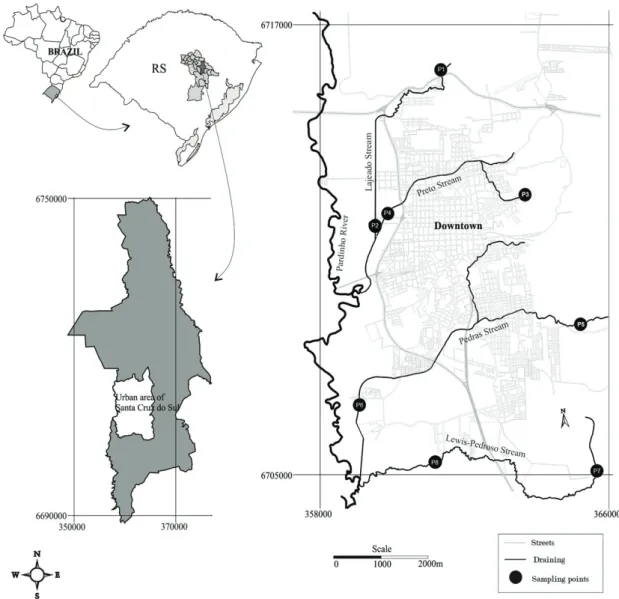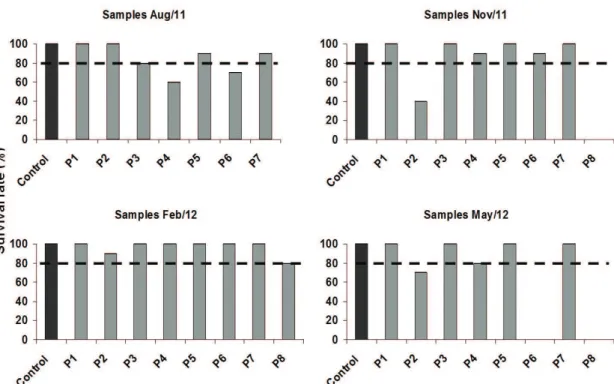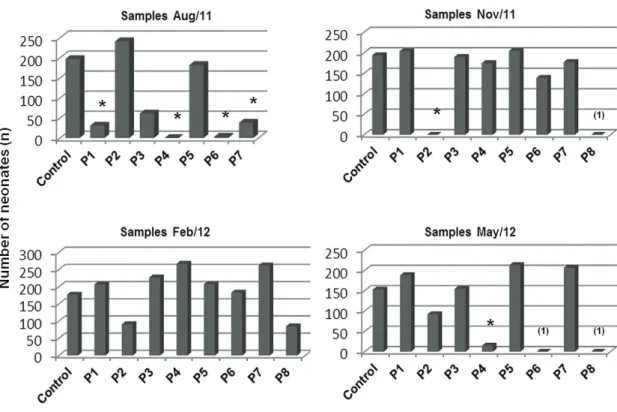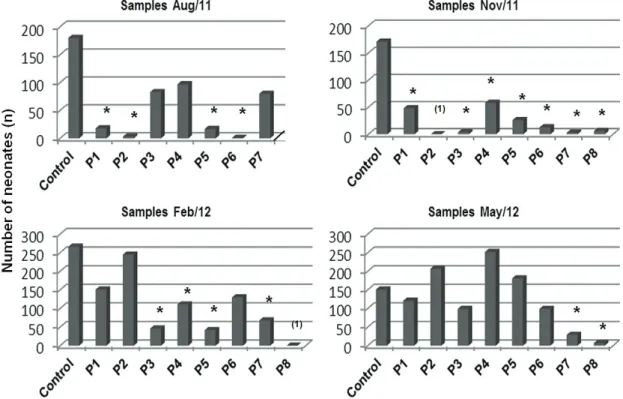Evaluation of water and sediment quality of urban streams in Santa
Cruz do Sul County, RS, Brasil, using ecotoxicological assays
Avaliação da qualidade da água e sedimento de arroios urbanos no município de Santa
Cruz do Sul, RS, Brasil, utilizando ensaios ecotoxicológicos
Luã de Vargas1, Camila Athanásio1, Adriana Düpont2, Adilson Ben da Costa2 and Eduardo Aléxis Lobo2
1Curso de Ciências Biológicas, Universidade de Santa Cruz do Sul – UNISC, CEP 96815-900,
Santa Cruz do Sul, RS, Brazil
e-mail: lua@unisc.br; camilaathanasio@hotmail.com
2Laboratório de Limnologia, Universidade de Santa Cruz do Sul – UNISC, Av. Independência, 2293,
CEP 96815-900, Santa Cruz do Sul, RS, Brazil e-mail: adrianad@unisc.br; adilson@unisc.br; lobo@unisc.br
Abstract:Aim: This study aimed to assess the quality of water and sediment of urban streams (Lajeado, Preto, Pedras and Lewis-Pedroso) located in Santa Cruz do Sul County, RS, Brazil, using the microcrustacean Ceriodaphnia dubia as test-organism. Methods:
Quarterly scientific excursions to the streams were held on August and November 2011, February and May of 2012 in order to collect water and sediment samples, in the upper reaches (P1, P3, P5, P7) and lower reaches (P2, P4, P6, P8), totalizing 8 points. To evaluate the toxicity (acute and chronic), the microcrustacean C. dubia was used. Results and conclusion: The results indicated high toxicity levels detected in samples P2, P6 and P8 (lower reaches), as they caused the mortality of 100% of organisms in the water samples (P6 and P8) and sediment samples (P2 and P8), denoting acute effect. Yet, all upstream sites showed chronic effects in sediment samples, at least for one collection period, with the highest significant toxicity level among all samples (55.2%), which indicates the presence of contamination even in upper areas. These results indicated a strong degradation of the water and sediment quality of urban streams coming from the wastewater and industrial discharges of the urban area, which can cause damage to the biota as well as the public health, due to the multiples uses of water that the local population does, highlighting many of them as inappropriate to the water quality detected, such as the primary contact recreation (balneability).
Keywords: environmental assessment, urban pollution, ecotoxicological assay, bioindicators.
Resumo: Objetivo: O presente estudo teve como objetivo avaliar a qualidade da água e do sedimento de córregos urbanos (Lajeado, Preto, Pedras e Lewis-Pedroso) localizados no município de Santa Cruz do Sul, RS, Brasil, utilizando o microcrustáceo
Ceriodaphnia dubia como organismo-teste. Métodos: Excursões científicas trimestrais foram realizadas nesses arroios, em agosto e novembro de 2011; fevereiro e maio de 2012, para coletar amostras de água e sedimento nos trechos superiores (P2, P4, P6 e P8) e nos trechos inferiores (P1, P3, P5 e P7), totalizando 8 pontos. Para avaliar a toxicidade (aguda e crônica), utilizou-se o microcrustáceo C. dubia. Resultados e conclusão: Os resultados indicaram alta toxicidade nos pontos P2, P6 e P8 (trechos inferiores), uma vez que causaram 100% de mortalidade dos organismos nas amostras de água (P6 e P8) e amostras de sedimento (P2 e P8), denotando efeito agudo. Ainda, todos os trechos superiores mostraram efeito crônico em amostras de sedimento, em pelo menos uma época de amostragem, com os maiores níveis de toxicidade significativa entre todas as amostras (55.2%), o que indica a presença de contaminação mesmos em trechos superiores. Estes resultados indicaram uma forte degradação da qualidade da água e do sedimento dos arroios urbanos proveniente das descargas de águas residuais e industriais da área urbana, que podem causar danos à biota, bem como a saúde pública, devido aos múltiplos usos de água que a população local faz, destacando muitos deles como inadequados para a qualidade da água detectada, como a recreação de contato primário (balneabilididade).
2014, vol. 26, no. 1, p. 18-25 Evaluation of water and sediment quality of urban streams… 19
and extensive knowledge about their biology highlighting Ceriodaphnia dubia as a benthic aquatic organism highly sensitive to environmental changes (Düpont and Lobo, 2012). Also, according to Sasson-Brickson and Burton (1991), C. dubia
has been successfully used for sediment toxicity evaluation.
In the State of Rio Grande do Sul, the Pardinho River is the main source of public water supply for the city of Santa Cruz do Sul, located roughly in the central region of the state. This city exhibits the largest human population as well as industrial activities in the basin; therefore the water quality of the Pardinho River is constantly influenced by human actions, highlighting the discharge of non-treated domestic sewage and industrial effluents, besides the influence of fertilizers and pesticides used in rural areas, particularly tobacco crops, rice, soybean and corn (Hermes et al., 2013).
Environmental monitoring studies in regional freshwater bodies conducted by the University of Santa Cruz do Sul have demonstrated that they already show advanced stages of organic pollution and eutrophication (Lobo and Callegaro, 2000; Lobo et al., 2002, 2004a, b, c, 2010; Oliveira et al., 2001; Hermany et al., 2006; Salomoni et al., 2006). These conditions have been also detected in Pardinho River and their main inflow streams, named Lajeado, Preto, Lewis-Pedroso and Pedras (Schuch et al., 2012). Furthermore, Hermes et al. (2013) claims that there was a significant increase of chemical pollutants in this basin, above environmental standards recommended by the National Council of the Brazilian Environment.
In this context, the aim of this research was to evaluate seasonally the quality of water and sediment of these four main streams running to the Pardinho River in the city of Santa Cruz do Sul, RS, from August 2011 to May 2012, through ecotoxicological assays using the microcrustacean Ceriodaphnia dubia as test-organism.
2. Methods
Quarterly scientific excursions to the four streams located in the city of Santa Cruz do Sul, RS (Lajeado, Preto, Pedras and Lewis-Pedroso) were held on August and November 2011, February and May of 2012 in order to collect water and sediment samples, in the upper reaches (P1, P3, P5, P7) and lower reaches (P2, P4, P6, P8), totalizing 8 points (Figure 1). Samples were collected, stored in appropriate containers and maintained in thermal
1. Introduction
To improve the quality of water is a major challenge for man in this century. Currently, the pollution of water resources is increasing rapidly, since rivers and others aquatic systems are been often polluted by the indiscriminate disposal of sewage, industrial waste and a multitude of human activities (Oliveira-Filho et al., 2008).
Due to a historical concern with standards of microbiological quality, where the goal is to ensure public health, the group of coliforms bacteria has been used as an indicator of water quality since 1904. These bacteria, however, can not survive in the presence of certain chemicals; therefore the absence of these bacteria can not be related with a good water quality (Doyle and Erickson, 2006). In addition, some methodologies based on instantaneous measurements of physical and chemical variables are used. In this case, however, the environmental monitoring only permits snapshot measurements, therefore restricting the knowledge of water conditions to the period when the measurements were taken. These limitations become somewhat more drastic when the object of study is a lotic system where the current promotes the continuous renewal of water in each location (Lobo and Callegaro, 2000).
In this sense, the aquatic ecotoxicology is an effective tool for monitoring, prevention and control of water quality especially in environments with contaminants difficult to identify, by measuring the impact of chemicals or complex mixtures on living organisms, using ecotoxicological assays. Studies assessing the quality of water bodies have undergone substantial changes, including the assessment of sediment quality, a compartment that was until recently considered only as an accumulator of nutrients and a variety of contaminants. Sediments are potential sources of contaminants in aquatic systems; therefore the analysis of pollutants in sediment is a tool of great importance for the study of anthropogenic pollution (Nascimento, 2008).
calculated using the statistical Trimmed Sperman-Karber method (Hamilton et al., 1979), with α = 5%.
C. dubia’s neonates between 6 and 24 hours were exposed to water samples and sediment elutriate samples for a minimum period of seven days, using 10 replicates for each sample and 10 replicates for the negative control. The bioassay was completed when 60% of adult organisms that survived in the negative control had produced at least 15 neonates, not exceeding the eighth day. For the test validity, the control should not present mortality exceeding 20% of test organisms as well as have at least an average of 15 neonates produced by each female.
Sediment elutriate samples were prepared based on ABNT (2007). The samples were mixed in a 1:4 (v/v) ratio of sediment to distilled/deionized water. They were vigorously homogenized, remaining on boxes for transportation, with temperatures below
10 °C.
The chronic toxicity tests were performed based on the Brazilian Standard NBR 13373 (ABNT, 2005), using Cerodaphnia dubia as test-organism. The stock cultures were grown in medium established by ABNT (2005), which has a total alkalinity of 40.0 to 48.0 mg L–1 as CaCO
3, and a pH between 7.5 and 7.6.
Culturing and toxicity testing were conducted at a temperature of 25 ± 2 °C and a photoperiod of 16h/08h light/dark. Culture medium was renewed once a week and females were fed with an algal suspension of Pseudokirchneriella subcapitata.
Also, the food was complemented with a solution of Artemia salina. To validate the bioassays, acute sensitivity tests were performed with potassium dichromate (K2Cr2O7). The EC(I)50 24h was
2014, vol. 26, no. 1, p. 18-25 Evaluation of water and sediment quality of urban streams… 21
bioassays, following the standards fixed by the Brazilian Standard NBR 13373 (ABNT, 2005).
In general, water samples showed acute toxicity along the four sampling times, in all streams, but only in downstream sites (P2, P4, P6 and P8) as shown in Figure 2, highlighting site P8 in November 2011 and May 2012, and site P6 in May 2012 because they showed the highest toxicity levels as they reached 100% of acute mortality.
Regarding to chronic effects, water samples showed toxicity in all seasons except February 2012 (Figure 3), with significant differences (p<0.05) in sites P2, P4 and P8 (lower reaches) and sites P1 and P7 (upper reaches), indicating sub-lethal effects.
Concerning the sediment samples, acute toxicity was verified along the four sampling times, but only in downstream sites (P2, P6 and P8), except P4 (Preto stream), as shown in Figure 4, highlighting site P2 in November 2011 and site P8 in February 2012 because they showed the highest toxicity levels as they reached 100% of acute mortality.
The chronic effect in sediment samples showed the highest significant toxicity level (p<0.05) among all samples (16/29 - 55.2%), in all seasons and streams (Figure 5), highlighting site P5 in August 2011, November 2011 and February 2012.
In a general way, it should be noted the high toxicity levels detected in samples P2, P6 and P8 desk during 24 h for decantation. After that, the
aqueous fraction (elutriate sample) was poured off and stored at 4 °C. Then, the test proceeded as for water samples.
The results for reproduction rate were analyzed using the statistical program GraphPad 5.0, applying the nonparametric statistical test of Kruskal-Wallis with Dunns post-test for multiple comparison between columns, considering a significance levels α = 5%. To interpretate the results obtained, three toxicity classes were considered (ABNT, 2005; CETESB, 2012):
(a) No toxic effect, if no significant differences were found in the survival and reproduction rates of organisms, compared with the nega-tive control;
(b) Toxic effect, if significant differences were found in the reproduction rates of organisms, compared with the negative control;
(c) Acute effect, if significant differences were found within 48h in the survival rates of or-ganisms, compared with the negative control.
3. Results and Discussion
Regarding the sensitivity tests, the average EC(I)50 24h for C. dubia exposed to potassium dichromate (K2Cr2O7) was 0.212 ± 0.046 mg L–1 (CV = 22.0%) thus validating the experimental
Figure 3. Total number of neonates (n) produced in each water sample during all sampling periods. The asterisk represents significant differences (p<0.05) compared to the negative control, showing chronic effect. (1) Without evaluation of chronic toxicity, because it showed 100% of acute mortality.
2014, vol. 26, no. 1, p. 18-25 Evaluation of water and sediment quality of urban streams… 23
that although the sites are located in the upper part of the streams, nowadays they are receiving a significant pollution load, probably originating from local domestic and agricultural activities.
In a similar way, Lucheta et al. (2010) working with bioassays using D. magna in sediment samples from Gravataí river, RS, a polluted water body by industrial and domestic wastes, verified a high chronic toxicity reaching 88% of all samples. Working in Gravataí River, this condition was also ratified by Salomoni et al. (2011), since a pollution gradient (organic and eutrophication) was detected from the headwaters to the mouth, mainly by considering a significant decrease in the concentration of dissolved oxygen and turbidity, as well as a significant increase in the biochemical oxygen demand, total nitrogen, ortho-phosphate and thermotolerant coliforms.
Although mortality rates between water and sediment samples did not show significant differences (p>0.05), it is remarkable the chronic effects observed in sediment samples (Figure 3 and 5). As Burton et al. (2001) pointed out, the sediment serves as a deposit of organic and inorganic materials and accumulates chemical substances of anthropogenic origin, whose contamination can cause harmful effects to the aquatic ecosystem, (lower reaches), as they caused the mortality of
100% of organisms in the water samples (P6 and P8) and sediment samples (P2 and P8), denoting acute effect, which indicates discharges of toxic wastes along the course of streams. A similar condition was verified in the environmental monitoring conducted in sediment samples of Sapucaia stream, RS (Portela et al., 2006), where the results of the toxicity essays using Hyalella azteca
and C. dubia as test-organisms, indicate an increase in environmental deterioration along the sampling locations, from upstream to downstream, mainly by domestic, industrial and agricultural discharges.
It is important to emphasize that all upstream sites showed chronic effects in sediment samples, at least for one collection period, with the highest significant toxicity level among all samples (55.2%), which indicates the presence of contamination even in upper areas. This condition was also verified by Schuch et al. (2012) in the study about the evaluation of water quality of these urban streams in Santa Cruz do Sul. The results indicated that the streams are polluted by organic contamination and advanced stages of eutrophication, highlighting that, in spite of the higher pollution levels were detected in the lower reaches, those located in the upper reaches were also contaminated, suggesting
Nova, vol. 31, no. 7, p. 1820-1830. http://dx.doi. org/10.1590/S0100-40422008000700038
DOYLE, MP. and ERICKSON, MC. 2006. Closing the door on the fecal coliform assay. Microbe, vol. 1, no. 4, p. 162-163.
DÜPONT A. and LOBO, EA. 2012. Evaluation of the efficiency of the sewage treatment plant from the University of Santa Cruz do Sul (UNISC), RS, Brazil. Acta Limnologica Brasiliensia, vol. 24, no. 2, p. 119-126. http://dx.doi.org/10.1590/S2179-975X2012005000031
HAMILTON, MA., RUSSO, RC. and THURSTON, RV. 1979. Trimmed Spearmann-Karber metod for calculation of EC50 and LC values in bioassays.
BurlingtonResearch, vol. 7, no. 1, p. 114-119. HERMANY, G., SCHWARZBOLD, A., LOBO, EA.
and OLIVEIRA, MA. 2006. Ecology of the epilithic diatom community in a low-order stream system of the Guaíba hydrographical region: subsidies to the environmental monitoring of southern Brazilian aquatic systems. Acta Limnologica Brasiliensia, vol. 18, no. 1, p. 25-40.
HERMES, N., SCHNEIDER RCS., MOLIN, DD., RIEGEL, GZ., COSTA, AB., CORBELLINI, VA., TORRES, JPM. and MALM, O. 2013. Environmental pathways and human exposure to manganese in southern Brazil. Annals of the Brazilian Academy of Sciences, vol. 85, no. 4, p. 1275-1288. PMid:24346793. http://dx.doi.org/10.1590/0001-3765201396912
LOBO, EA. and CALLEGARO, VL. 2000. Avaliação da qualidade de águas doces continentais base em algas diatomáceas epilíticas: Enfoque metodológico. In TUCCI, CEM. and MARQUES, DM. (Org.).
Avaliação e Controle da Drenagem Urbana. Porto Alegre: Ed. UFRGS. p. 277-300.
LOBO, EA., CALLEGARO, VL. and BENDER, P. 2002. Utilização de algas diatomáceas epilíticas como indicadoras da qualidade da água em rios e arroios da Região Hidrográfica do Guaíba, RS, Brasil. Santa Cruz do Sul: EdUNISC.
LOBO, EA., CALLEGARO, V. L., HERMANY, G., BES, D., WETZEL, C. E. and OLIVEIRA, M. A. 2004a. Use of epilithic diatoms as bioindicator from lotic systems in southern Brazil, with special emphasis on eutrophication. Acta Limnologica Brasiliensia, vol. 16, no. 1, p. 25-40.
LOBO, EA., CALLEGARO, VL., HERMANY, G., GOMEZ, N. and ECTOR, L. 2004b. Review of the use of microalgae in South America for monitoring rivers, with special reference to diatoms. Vie et Milieu, vol. 53, no. 2-3, p. 35-45.
LOBO, EA., CALLEGARO, VL., HERMANY, G., BES, D., WETZEL, CE. and OLIVEIRA, MA. 2004c. Use of epilithic diatoms as bioindicator from lotic systems in southern Brazil, with special emphasis on
not only in the benthic organisms but in the other component of the food webs, since the sediment can supply habitat, food and reproduction sites for organisms occupying different trophic levels (Baudo et al., 1999).
All the streams cross the urban area of the city, but they flow in different directions and therefore are subject to different sources of contamination. The Pedras stream (P5, P6) is mostly contaminated by domestic sewage while the Lewis-Pedroso stream (P7, P8) is located near the industrial area, receiving wastewater from the industries. These differences can partially explain the reason for the differences in toxicity between the two streams, since domestic sewage usually presents a lower level of toxicity.
In a general way, these results indicated a strong degradation of the water and sediment quality of urban streams coming from the wastewater and industrial discharges of the urban area, which can cause damage to the biota as well as the public health, due to the multiples uses of water that the local population does, highlighting many of them as inappropriate to the water quality detected, such as the primary contact recreation (balneability).
This research allows us to certify the validity of using bioassays for the sediment quality evaluation in rivers, since these microorganisms are not selective, accumulating xenobiotics that contribute for the toxicity, both acute and chronic.
References
Associação Brasileira de Normas Técnicas - ABNT. 2005.
NBR 13373.Ecotoxicologia aquática - Toxicidade crônica - Método de ensaio com Ceriodaphnia spp. (Crustácea, Cladócera). Rio de Janeiro: ABNT. Associação Brasileira de Normas Técnicas - ABNT. 2007.
NBR 15469: Ecotoxicologia aquática - Preservação e Preparo de amostras. Rio de Janeiro: ABNT. BAUDO, R., BELTRAMI, M. and ROSSI, D. 1999. In
situ tests to assess the potencial of aquatic sediments.
Aquatic Ecosystem Health and Management, vol. 2, p. 361-365.
BURTON G. A., BAUDO, R., BELTRAMI, M. and ROWLAND, C. 2001. Assessing sediment contamination using six toxicity assays. Journal of Limnology, vol. 60, no. 2, p. 263-267. http://dx.doi. org/10.4081/jlimnol.2001.1.263
Companhia Ambiental do Estado de São Paulo - CETESB. 2012. Variáveis de qualidade das águas. Available from: <http://www.cetesb.sp.gov.br/agua/aguas-superficiais/34>. Access in: 24 July 2012.
2014, vol. 26, no. 1, p. 18-25 Evaluation of water and sediment quality of urban streams… 25
epiphytic diatom species on artificial substrate in lotic environments in the Arroio Sampaio basin, RS, Brazil: relationships with abiotic variables. Revista Brasileira de Biologia, vol. 61, no. 4, p. 523-540. PORTELA, CMS., ARENZON, A. and
RAYA-RODRIGUEZ, MT. 2006. Avaliação ecotoxicológica do sedimento do Arroio Sapucaia, RS, Brasil, através de ensaios de toxicidade utilizando diferentes amostradores e organismos-teste. Journal of the Brazilian Society of Ecotoxicology, vol. 1, no. 2, p. 119-122. http://dx.doi.org/10.5132/jbse.2006.02.005 SALOMONI, SE., ROCHA, O., CALLEGARO, VL.
and LOBO, EA. 2006. Epilithic diatoms as indicators of water quality in the Gravatai River, Rio Grande do Sul, Brazil. Hydrobiologia, vol. 559, p. 233-246. http://dx.doi.org/10.1007/s10750-005-9012-3 SALOMONI, SE., ROCHA, O., HERMANY, G. and
LOBO, EA. 2011. Application of water quality biological indices using diatoms as bioindicators in Gravataí River, RS, Brazil. Brazilian Journal of Biology, vol. 71, no. 4, p. 949-959.
SASSON-BRICKSON, G. and BURTON GA. 1991. In situ and laboratory sediment toxicity testing with Ceriodaphnia dubia. Environment Toxicology and Chemistry, vol. 10, p. 201-207. http://dx.doi. org/10.1002/etc.5620100208
SCHUCH, M., ABREU-JUNIOR, E. and LOBO, EA. 2012. Water quality evaluation of urban streams in Santa Cruz do Sul City, RS, Brazil. Bioikos, vol. 26, no. 1, p. 3-12.
Received: 23 October 2013 Acepted: 07 May 2014 eutrophication. Acta Limnologica Brasiliensia, vol. 16,
no. 1, p. 25-40.
LOBO, EA., WETZEL, CE., ECTOR, L., KATOH K., BLANCO, S. and MAYAMA, S. 2010. Response of epilithic diatom community to environmental gradients in subtropical temperate Brazilian rivers.
Limnetica, vol. 29, no. 2, p. 323-340.
LUCHETA, F., FEIDEN, IR., GONÇALVES, SP., SCHONS JG. and TERRA R. 2010. Avaliação da qualidade dos sedimentos do rio Gravataí (Rio Grande do Sul, Brasil) a partir de testes de toxicidade utilizando Daphnia magna (Straus, 1820) como organismo-teste. Acta Limnologica Brasiliensia, vol. 22, no. 4, p. 367-377. http://dx.doi. org/10.4322/actalb.2011.002
NASCIMENTO, LA. 2008. Avaliação da influência da produção de petróleo na concentração de metais traços e orgânicos em sedimentos da bacia Piranhas-Açu. Natal: Universidade Federal do Rio Grande do Norte. 108 p. [Dissertação de Mestrado em Engenharia de Petróleo].
OLIVEIRA-FILHO, EC., PARRON, LM., FREIRE, IS., CRUZ, CJD., MUNIZ, DHF. and ROCHA, ALA. 2008. Utilização do microcrustáceo Ceriodaphnia dubia na avaliação da qualidade de águas superficiais em sub-bacias do Rio Preto. In Anais do IX Simpósio Nacional Cerrado: Desafios e estratégias para o equilíbrio entre sociedade, agronegócio e recursos naturais, 2008. Brasília.



